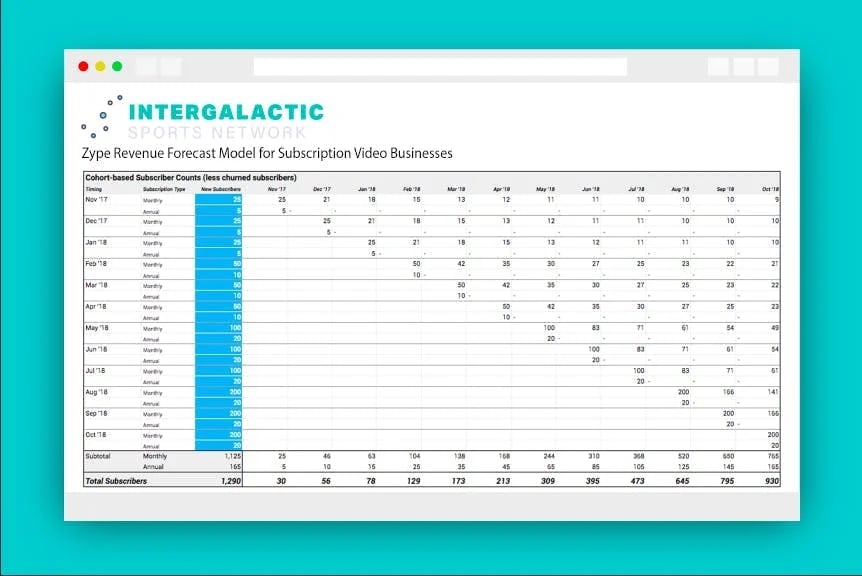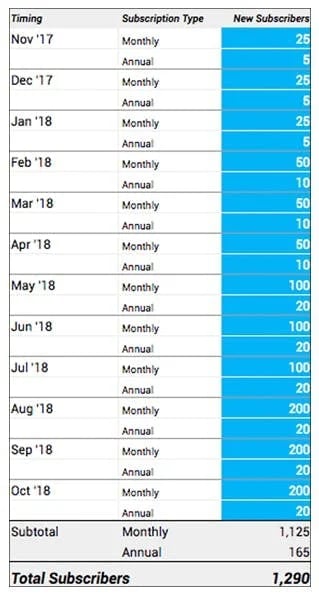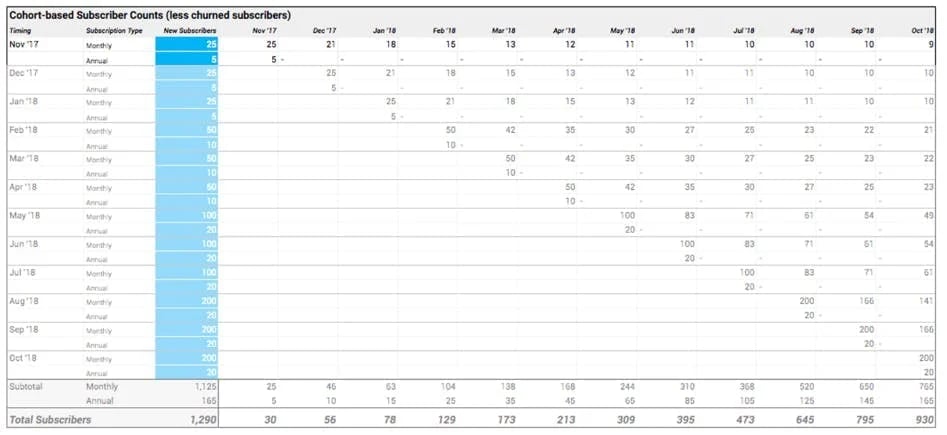How much money should I expect to make? This is the most critical question for content owners to ask themselves as they launch their subscription video business. You must have the ability to estimate your revenue earning potential in order to make the best decisions for your brand and content.
We created and shared this subscription revenue forecast spreadsheet to help content owners as they plan the launch of their SVOD service, or just to explore how much money it would be possible to make. Many of our customers continue to use this tool as they build their business to forecast revenue beyond the first year running their service.
We realize that this spreadsheet can seem intimidating, especially if you aren’t used to working with financial models. Don’t worry! We’re going to walk through how to use the model, from the assumptions you’ll need to consider, to what it means for your business. You’ll find that it’s very easy to use.
Building a Realistic Case
Before we dig into things, it’s important to preface that like any other financial model - this will only be as accurate as the numbers you put in. If you input overly optimistic numbers, you’ll get an inflated and unrealistic result out. Is it possible for you to add 10,000 subscribers in the first month? Anything is possible, but is that really realistic?
Do some research, use what data you have and always keep your assumptions on the conservative side. In order for this tool to be valuable, you must build a realistic case with attainable assumptions.
How to Use the Model
Intergalactic Sports is a fictional company that we’ll use to work through an example with the model. To make it as realistic as possible, the assumptions that we’ll use are based on industry benchmarks and informed by our experience with our customers.

Revenue Assumptions
We’ll start by inputting your basic revenue assumptions into our model, these include:
Starting month - When are you going to launch?
Hours of new content - How many hours of content are you going to be uploading per month?
Subscription Price - How much are you charging for your subscription? Will you offer both monthly and annual subscriptions? Or monthly only?

In this model, Intergalactic Sports is launching next month and they plan to upload around 35 hours of new content to Zype every month. They’ll be offering both a monthly and annual subscription.
Cost Assumptions
Next, you’ll input any fixed and variable costs into the model.

Here, Intergalactic Sports is using the Zype platform to power their SVOD service, they pay $1000/month for the network plan, which ends up being a fixed cost of $12,000/year for their software license. The other costs we inputted include:
Zype Costs
Zype charges a $0.95 transaction fee for each subscriber. The other platform cost is a $3.00 per hour to transcode new content, which is a one-time fee that applies only to NEW content that is uploaded.
Payment Processor Fees
These are standard fees charged by payment processor providers like Braintree or Stripe. This includes a fixed fee per transaction and a variable percentage of each transaction.
Subscription Assumptions
The last inputs into the model will be related to subscribers and churn, these will be what ultimately drives your revenue and determines how quickly you'll be profitable.
New Subscribers
Starting with your subscribers, you’ll input how many new monthly and annual subscribers you anticipate to bring on over the next year. You’ll see we stayed on the conservative-side of subscribers for Intergalactic Sports, slowly ramping up from 25 new monthly subscribers to 200 near the end of the twelve-month period.

Lastly, but most importantly, you’ll input the percentage of subscribers you expect to cancel month to month, over the course of 12 months.

We based Intergalactic Sport’s churn on industry benchmarks - an average of 15-20% churn rate per month. For context, companies like Netflix and Hulu have 8-15% monthly churn rates. Churn plays a critical role in a subscription business, read more about the strategies and metrics that are involved in this model, here.
What does the Model Mean for Your Business?
Now everything is inputted, your spreadsheet starts to get interesting. The model uses a cohort-based approach, which is useful for providing insight into how subscriber churn is affecting revenue because it tracks the behavior of each cohort of subscribers over time.
There are three main sections of the spreadsheet that calculate your total number of subscribers, subscription revenue, and costs.
First, we’ll dig into your cohort subscriber counts. This section accounts for those subscriber signing up and those churning out.

You’ll notice that over time each month’s group of subscribers declines as customers cancel their subscriptions. That’s churn in action. You’ll also notice that eventually the original cohort of customers that signed up normalizes. Your churn rate goes down over time for each cohort because you’re left with your fans who are most loyal and willing to pay to stay subscribed. Any subscribers who are going to churn will most likely cancel within the first few months.
How Long Will it Take to Break-Even?
The key section of the spreadsheet is ultimately the summary and break-even analysis. This simplifies all the sections from your revenue, costs and subscribers into one simple summary. Here you’ll find one of the most important insights from the model - how long it will take you to break even and be' in the green' with your current inputs.
With the assumptions we inputted, it will take Intergalactic Sports six months to break even. That’s with pretty conservative assumptions for subscriber growth. If you increase the number of subscribers each month, you’ll break even sooner. This is why attaining subscribers AND retaining subscribers is so essential to an SVOD businesses’ revenue and growth.
We hope you find this guide and the model useful!